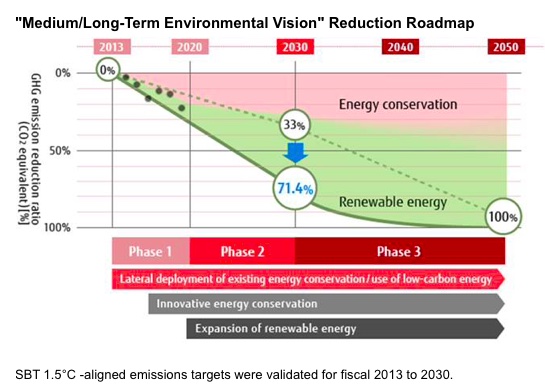
TOKYO, Apr 16, 2021 - (JCN Newswire) - Fujitsu today announced a significant update to its greenhouse gas reduction targets as efforts towards decarbonization gain increasing urgency and accelerate throughout the world. To contribute more aggressively to the resolution of environmental issues confronting humanity, Fujitsu revised its emissions reduction targets for its business sites in FY 2030 from 33% to 71.4% below FY 2013 levels. On April 15, these were successfully validated as 1.5 degC-aligned targets by the Science Based Targets initiative (SBTi, 1).

Fujitsu simultaneously issued the "Fujitsu Group Environmental Action Plan (Stage X)," which will guide stakeholders throughout the global organization in contributing to the achievement of its environmental targets for FY 2021 and FY 2022.
Fujitsu's Environmental Action Plan demonstrates its ongoing commitment to proactively reducing the environmental footprint of its business activities, including throughout its supply chain, and will continue contributing to the decarbonization of customers and society, adapt to mitigate the harmful impacts of climate change, and resolve pressing environmental and social issues through technology.
Background
In May 2017, Fujitsu first formulated its medium- and long-term environmental vision, "Fujitsu Climate and Energy Vision," and in August of the same year, obtained SBT certification for 2degC-aligned emissions reduction targets. The SBTis are intended to significantly reduce GHG emissions over the medium to long term based on scientific knowledge compiled by the IPCC (2) and other organizations.
The Global Risks Report 2021 identifies "Natural resource crisis" and "Biodiversity loss" in addition to "Climate action failure" as environmental risks posing a high impact and high probability of occurrence. Bearing these factors in mind, Fujitsu has set targets for the two years from FY 2021 as the "Fujitsu Group Environmental Action Plan (Stage X )" under three key areas.
Overview of "Fujitsu Group Environmental Action Plan (Stage X)"
Fujitsu is identifying priority areas based on the life cycle of the products and services it provides and will set and promote nine targets from the three perspectives of "Climate change," "Resource circulation," as well as "Co-existence with nature."
In the area of "Climate Change," Fujitsu will strategically promote energy conservation and the introduction of renewable energy resources by leveraging advanced technologies to achieve emissions reductions targets aligned with 1.5degC, in order to achieve our targets for decarbonization and mid- to long-term GHG reduction. With regard to "Resource circulation," Fujitsu will strengthen its efforts to collect information on water and measures to mitigate the impacts of climate change from suppliers using the CDP Supply Chain Program (3) to promote the resource-saving design of products (focus on measures for reuse and reduce the use of plastic) as well as understanding and reducing environmental impact throughout the supply chain. In the "Co-existence with nature" area, Fujitsu will set new targets for visualizing the impact of corporate activities on biodiversity.
(1) SBTi (Science Based Targets initiative):
An initiative jointly established by the United Nations Global Compact, the World Resources Institute (WRI: World Resources Institute), and other organizations in 2015. It encourages companies to set GHG emission reduction targets consistent with science-based evidence to the level required by the Paris Agreement, validating targets that comply with criteria including indirect emissions not only within the company but also in the supply chain.
(2) IPCC (Intergovernmental Panel on Climate Change):
An abbreviation for "United Nations Intergovernmental Panel on Climate Change" established in 1988 by the United Nations Environment Programme (UNEP) and the World Meteorological Organization (WMO) for the purpose of carrying out comprehensive assessments from scientific, technological and socio-economic perspectives on anthropogenic climate change, impacts, adaptation and mitigation measures.
(3) CDP Supply Chain Program:
The CDP is an international non-profit organization that manages global disclosure for companies' activities relating to climate change, forests, and water security, on behalf of institutional investors that have total investment assets in excess of $110 trillion. The CDP Supply Chain Program is a scheme in which companies, governments, and other program members request suppliers to respond to a survey on environmental impact, and the results are fed back to the program members.
About Fujitsu
Fujitsu is the leading Japanese information and communication technology (ICT) company offering a full range of technology products, solutions and services. Approximately 130,000 Fujitsu people support customers in more than 100 countries. We use our experience and the power of ICT to shape the future of society with our customers. Fujitsu Limited (TSE:6702) reported consolidated revenues of 3.9 trillion yen (US$35 billion) for the fiscal year ended March 31, 2020. For more information, please see www.fujitsu.com.
Copyright 2021 JCN Newswire. All rights reserved. www.jcnnewswire.com
